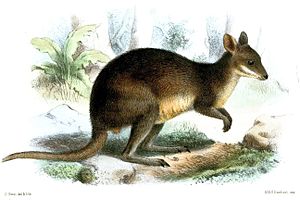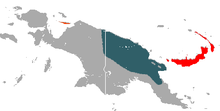Northern New Guinea filander
| Northern New Guinea filander | ||||||||||||
|---|---|---|---|---|---|---|---|---|---|---|---|---|

Northern New Guinea filander ( Thylogale browni ) |
||||||||||||
| Systematics | ||||||||||||
|
||||||||||||
| Scientific name | ||||||||||||
| Thylogale browni | ||||||||||||
| ( Ramsay , 1887) |
The Northern New Guinea Filander ( Thylogale browni ) is a species of kangaroo from the genus Filander ( Thylogale ). Until recently, it was considered a subspecies of the New Guinea Filander .
features
They are relatively small, stocky representatives of the kangaroos, they can weigh three to nine kilograms. Their fur is dark brown on the top, the underside is lighter. As with most kangaroos, the hind legs are long and strong, while the front legs are significantly shorter.
The species resembles the mountain filander ( Thylogale lanatus ) in external appearance. Both species lack light stripes on the hips and shades of yellow on the ends of the hair on the underside. In the Northern New Guinea filander, the hairs on the underside can have a gray base and white tips or be completely gray. Compared to the mountain filander, the fur is less woolly, the tail less hairy and there is no light coat on the shoulder. The species has hind feet 10.0 to 16.7 cm long and ears 3.9 to 6.0 cm long. Females are smaller than males with a head body length of 48.7 to 56.0 cm and a tail length of 30.0 to 42.5 cm. The latter reach a head body length of 53.5 to 66.7 cm and a tail length of 36.6 to 52.0 cm.
Distribution and way of life
These animals live in northern and northeastern New Guinea , as well as on the islands of the Bismarck Archipelago , but the populations there were probably introduced by humans. Their habitat are tropical forests. Hardly anything is known about their way of life; like all Filanders, they are probably nocturnal loners who feed on grass and leaves.
The species probably prefers secondary forests and forest edges, visiting grasslands at high altitude. A litter usually consists of one cub.
status
The main threat to these animals is the hunt for their meat. The IUCN estimates that the total population has declined by over 30% in the last 15 to 20 years and lists the species as "endangered" ( vulnerable ).
literature
- Ronald M. Nowak: Walker's Mammals of the World. 6th edition. Johns Hopkins University Press, Baltimore 1999, ISBN 0-8018-5789-9 .
- DE Wilson, DM Reeder: Mammal Species of the World. Johns Hopkins University Press, Baltimore 2005, ISBN 0-8018-8221-4 .
supporting documents
- ^ TF Flannery: Taxonomic Revision of the Thylogale brunii Complex . In: Australian Mammal Society . 15, 1992, pp. 14-16.
- ^ A b Thylogale browni in the IUCN Red List of Endangered Species . Posted by: Leary, T., Seri, L., Flannery, T., Wright, D., Hamilton, S., Helgen, K., Singadan, R., Menzies, J., Allison, A. & James, R., 2016. Retrieved February 26, 2018 ..
